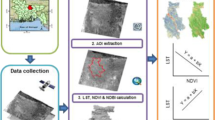Abstract
The green vegetation fraction (GVF) and surface albedo are important land surface parameters often used for validation of climate and land surface models that are influenced largely by environmental gradients and human activities. In this study, fine resolution GVF and albedo values derived from Landsat Thematic Mapper/Enhanced Thematic Mapper Plus images from 1990 to 2000 were used to examine the relationship of both GVF and albedo values to the spatial gradients of parameters related to dramatic urbanization in the Greater Guangzhou metropolitan area, Guangdong Province, in South China. Moderate resolution GVF and albedo datasets derived from the MODIS Collection 5 product were used to analyze the seasonal variation of GVF and albedo with rapid urban expansion from 2001 to 2007. The results show that the shortwave albedo had a clear declining trend from the urban center to natural land in 1990. However, no obvious trend in shortwave albedo change was observed along urban–rural gradients caused by the expansion of low-albedo urban buildings and more heterogeneous land cover patterns in 2000. A threshold of GVF (~0.21) was estimated for determining the change of albedo associated with vegetation fraction. Vegetation cover modified by urban expansion changed surface reflectance and influenced the surface energy balance. It is suggested that a large portion of energy absorbed in an urban area is likely to be converted to thermal energy that heating up is near the surface and emitted as longwave radiation.







Similar content being viewed by others
References
Brest CL (1987) Seasonal albedo of an urban–rural landscape from satellite-observations. J Climate Appl Meteorol 26:1169–1187
Christen A, van Gorsel E, Vogt R (2007) Coherent structures in urban roughness sublayer turbulence. Int J Climatol 27:1955–1968
Comins NF, Kaufmann III WJ (2002) Discovering the universe. W.H. Freeman and Company, New York
Dobos E (2006) Albedo. In: encyclopedia of soil science. Taylor & Francis, London
Foley JA, DeFries R, Asner GP, Barford C, Bonan G, Carpenter SR, Chapin FS, Coe MT, Daily GC, Gibbs HK, Helkowski JH, Holloway T, Howard EA, Kucharik CJ, Monfreda C, Patz JA, Prentice IC, Ramankutty N, Snyder PK (2005) Global consequences of land use. Science 309:570–574
Gallo K, Tarpley D, Mitchell K, Csiszar I, Owen T, Reed B (2001) Monthly fractional green vegetation cover associated with land cover classes of the conterminous USA. Geophys Res Lett 28:2089–2092
Gomez F, Jabaloyes J, Vano E (2004) Green zones in the future of urban planning. J Urban Plan D-ASCE 130:94–100
Grimm NB, Faeth SH, Golubiewski NE, Redman CL, Wu JG, Bai XM, Briggs JM (2008) Global change and the ecology of cities. Science 319:756–760
Gutman G, Ignatov A (1998) The derivation of the green vegetation fraction from NOAA/AVHRR data for use in numerical weather prediction models. Int J Remote Sens 19:1533–1543
Hamdi R, Schayes G (2008) Sensitivity study of the urban heat island intensity to urban characteristics. Int J Climatol 28:973–982
Jenerette GD, Harlan SL, Brazel A, Jones N, Larsen L, Stefanov WL (2007) Regional relationships between surface temperature, vegetation, and human settlement in a rapidly urbanizing ecosystem. Landscape Ecol 22:353–365
Liang SL (2000) Narrowband to broadband conversions of land surface albedo I algorithms. Remote Sens Environ 76:213–238
Middleton EM (1991) Solar zenith angle effects on vegetation indexes in tallgrass prairie. Remote Sens Environ 38:45–62
Montandon LM, Small EE (2008) The impact of soil reflectance on the quantification of the green vegetation fraction from NDVI. Remote Sens Environ 112:1835–1845
Oke TR (1982) The energetic basis of the urban heat-island. Q J Roy Meteor Soc 108:1–24
Palle E, Goode PR, Montanes-Rodriguez P, Koonin SE (2004) Changes in earth’s reflectance over the past two decades. Science 304:1299–1301
Roesch A, Roeckner E (2006) Assessment of snow cover and surface albedo in the ECHAM5 general circulation model. J Clim 19:3828–3843
Román MO, Gatebe CK, Shuai YM, Wang ZS, Gao F, Masek JG, He T, Liang SL, Schaaf CB (2013) Use of in situ and airborne multiangle data to assess MODIS- and Landsat-based estimates of directional reflectance and albedo. IEEE Trans Geosci Remote Sens 51:1393–1404
Sailor DJ (1995) Simulated urban climate response to modifications in surface albedo and vegetation cover. J Appl Meteorol 34:1694–1704
Smith MO, Ustin SL, Adams JB, Gillespie AR (1990) Vegetation in deserts: I. A regional measure of abundance from multispectral images. Remote Sens Environ 31:1–26
Wang YG, Meng DP, Zhu Y, Feng Z (2009) Impacts of regional urbanization development on plant diversity within boundary of built-up areas of different settlement categories in Jinzhong Basin, China. Landscape Urban Plan 91:212–218
Wang ZS, Schaaf CB, Chopping MJ, Strahler AH, Wang JD, Román MO, Rocha AV, Woodcock CE, Shuai YM (2012) Evaluation of moderate-resolution imaging Spectroradiometer (MODIS) snow albedo product (MCD43A) over tundra. Remote Sens Environ 117:264–280
Weng Q (2001) A remote sensing–GIS evaluation of urban expansion and its impact on surface temperature in the Zhujiang Delta, China. Int J Remote Sens 22:1999–2014
Winton M (2006) Surface albedo feedback estimates for the AR4 climate models. J Clim 19:359–365
Zeng XB, Dickinson RE, Walker A, Shaikh M, DeFries RS, Qi JG (2000) Derivation and evaluation of global 1-km fractional vegetation cover data for land modeling. J Appl Meteorol 39:826–839
Acknowledgments
This study was supported by the Strategic Priority Research Program of the Chinese Academy of Sciences (XDA05090200), the National Basic Research Program of China (2009CB723904), the Arid Science Project (IAM201212) and the National Natural Science Foundation of China (41201044). We thank the anonymous reviewers and the editor-in-chief for their constructive comments.
Author information
Authors and Affiliations
Corresponding author
Rights and permissions
About this article
Cite this article
Hou, M., Hu, Y. & He, Y. Modifications in vegetation cover and surface albedo during rapid urbanization: a case study from South China. Environ Earth Sci 72, 1659–1666 (2014). https://doi.org/10.1007/s12665-014-3070-7
Received:
Accepted:
Published:
Issue Date:
DOI: https://doi.org/10.1007/s12665-014-3070-7



